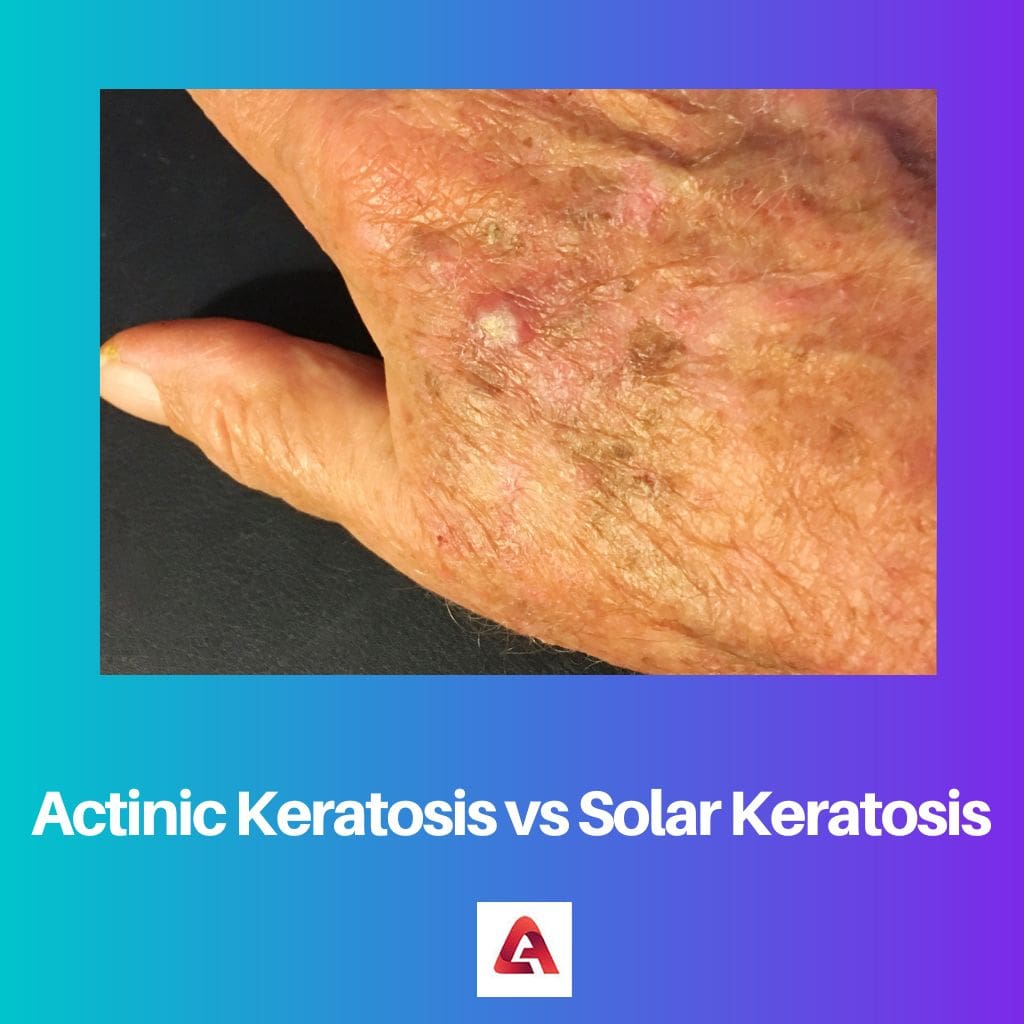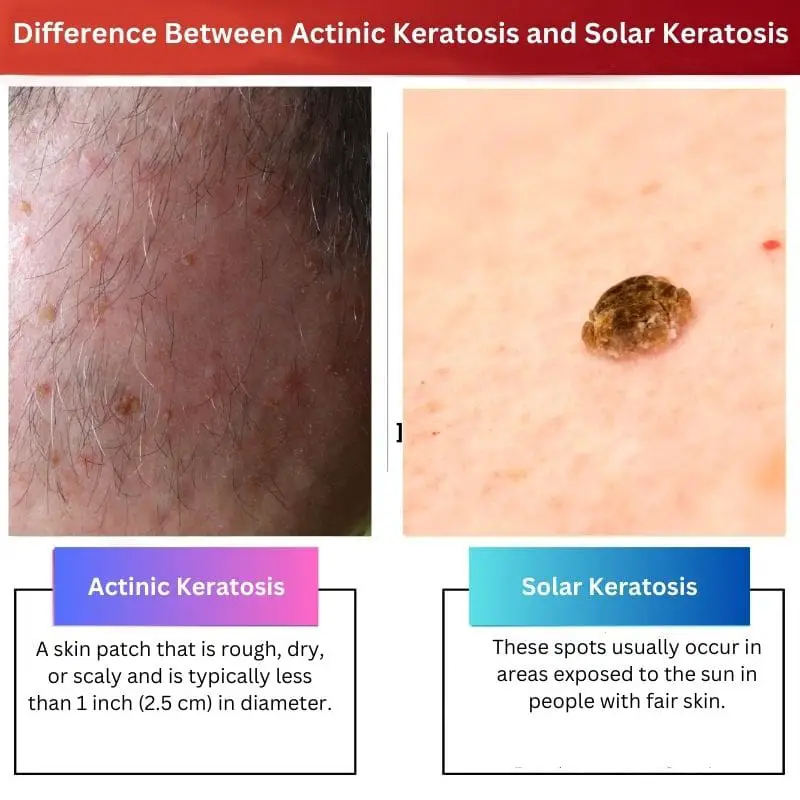Keratosis is a precancerous skin condition resulting from prolonged exposure to the sun. Most often, keratoses of the skin occur in the elderly, but recently there has been a trend toward rejuvenation of the disease. According to statistics, the more time a person has spent in the open sun in his life and the more sunburns he has received, the higher the risk of developing keratosis during ageing.
Although a significant number of cases of squamous cell carcinoma have an association with actinic keratosis, the risk of the latter progressing to skin cancer is relatively low. Unfortunately, no reliable histologic criteria can accurately predict which cases of actinic keratoses will or will not transform into skin cancer.
Key Takeaways
- Actinic and solar keratosis are the same conditions, characterized by rough, scaly patches on sun-exposed skin.
- Both terms describe skin lesions resulting from chronic sun exposure and damage.
- Actinic keratosis can develop into skin cancer if left untreated, making early detection and treatment essential.

Actinic Keratosis vs Solar Keratosis
Actinic keratoses (AK) are skin lesions (in the form of neoplasms) caused by exposure of the skin to sunlight. It mainly occurs on the face, ears, back of the hands, and in men – on bald spots. On the other hand, Solar keratosis is a precancerous skin disease in the form of multiple limited dense foci of hyperkeratosis (increased thickness of the stratum corneum, or outer skin layer) occurring on the skin areas exposed to excessive insolation in persons with fair skin, in blondes.
Comparison Table
| Parameters of Comparison | Actinic Keratosis | Solar Keratosis |
|---|---|---|
| Definition | Skin lesions | Common precancerous lesion of the skin |
| Causes | Ultraviolet (UV) exposure | By frequent or intense exposure to ultraviolet rays |
| Symptoms | Areas of skin may appear scaly, rough, or thickened | Rough patch of skin, may feel itchy and dry |
| Risk factor | Age, gender, sunny climate | Skin type, age, geographic location |
| Treatment | Removal of actinic keratosis | Prescription creams and gels. |
What is Actinic Keratosis?
Actinic keratoses are pathological changes in the skin caused by direct and prolonged exposure to solar radiation. This pathology has developed over many years. Therefore, this disease rarely occurs in young children. But in older people – quite often.
Many experts say that the treatment of actinic keratoses can not be carried out at all. After all, the pathology, in most cases, does not pose a health risk, and there are known cases of regression. Such therapeutic strategy as observation is justified if a single focus of a small diameter has no effect on the appearance and is not considered a cosmetic defect.
However, if additional symptoms occur, such as a change in shape, soreness, or redness of the skin around the lesion, you should consult a dermatologist.
Removal of actinic keratosis is the only way to treat this skin pathology. There are several methods of solving the problem. The doctor determines the best of them, depending on individual characteristics – the number and location of the foci, the diameter, and thickness.
- Treatment with liquid nitrogen. The lesion is cauterized with a substance, and the pathology disappears after healing the wound. But the skin around it can also be damaged due to the impossibility of precise nitrogen exposure. The wound takes a long time to heal. The advantage of try destruction is the affordable cost and relative ease of manipulation.
- In some cases, surgical removal of the lesion is performed. The disadvantage of excision with a scalpel is the high risk of scarring in the affected area, and the wound after surgery takes a long time to heal.
- Laser treatment of actinic keratoses involves the removal of abnormal tissues through a laser unit, which is widely used in modern dermatology.
Actinic keratoses appear as red or pink patches on the skin that are flat or slightly elevated above the skin surface. There may be single and multiple lesions. Single spots vary in size from a few millimetres to 3 centimetres in diameter. The spots themselves are dry and rough. Scales and crusts appear on the skin in the area of the lesions.

What is Solar Keratosis?
Solar keratosis is the most common precancerous lesion of the skin, characterized by local intraepidermal atypia of keratinocytes in exposed areas of the body exposed to sunlight. The mechanism of its occurrence is related to the damaging effect of ultraviolet radiation and other associated carcinogenic factors on keratinocytes. The development of solar keratosis is associated primarily with exposure to UVB (290-320 nm). UVA spectrum A (320-400 nm) increases the damaging effect of UVB.
Solar keratosis affects elderly people with fair skin. The incidence and prevalence of the disease correlate with the intensity of solar radiation.
The risk group for solar keratosis includes people working outdoors (agricultural workers, sailors, fishermen, mountain climbers, athletes, etc.). In the conditions of the modern environment and ecological situation, special attention should be paid to the amount of insolation.
Clinically, solar keratosis manifests by multiple, clustered, limited dense foci of hyperkeratosis on skin areas exposed to excessive insolation. It occurs on the face (forehead, nose, cheeks, temples, red border of the lower lip), auricles (in men), lateral surfaces of the neck, forearms, back of the hands, and lower legs (in women).
As a rule, rashes are determined against a background of atrophic skin changes. Initially, the rash is represented by slightly painful spots or papules ranging in size from pinheads to several centimetres in diameter, their color ranging from normal skin to red or gray-black. They are better recognized by palpation than by examination. Subjective sensations of solar keratoses are absent.
Main Differences Between Actinic Keratosis and Solar Keratosis
Actinic Keratosis
- A skin patch that is rough, dry, or scaly and is less than 1 inch (2.5 cm) in diameter.
- The top layer of skin has a hump or patch that is flat or hardly elevated.
- Occasionally, a rough, wart-like surface.
- Variations in color, such as pink, red, or brown.
- Crusting, bleeding, itching, or burning.
Solar Keratosis
- These spots occur in areas exposed to the sun in people with fair skin.
- The risk group for solar keratosis includes people working outdoors.
- 3% of the time, solar keratosis metastasizes or spreads to internal organs.
- Solar keratosis is a type of precancer, which means that if left untreated, the condition can develop into cancer.
- Caused by ultraviolet (UV) damage to the skin.

